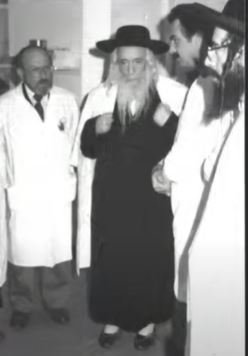
Building a hospital is not a
typical endeavor for a chaddishe rebbe. But the Klausenberger Rebbe, Rabbi
Yekusiel Yehudah Halberstam, zt”l, wasn’t
a typical rebbe.
Born
in 1905, in Rudnik, Poland, young Yekusiel Yehudah showed signs of greatness
early on. As a child, his primary teacher was his father, Rav Tzvi Hirsch
Halberstam, who was also the rav of the town. The Klausenberger Rebbe stated
that the time he spent learning with father – formally and informally – made an
everlasting impression on him even though his father passed away when he was
only 13.
Yekusiel
Yehudah went on to study with great talmidei
chachamim, including the Munkatcher Rebbe, Rabbi Chaim Elazar Shapiro. It
was during this time that Yekusiel Yehudah would be dubbed the “Rudnika Ilui.”
Although
he was a great-grandson of the saintly Divrei Chaim – Rabbi Chaim Halberstam
Sanzer – Yekusiel Yehudah would create his own unique legacy as a brilliant
scholar and selfless, pious leader.
In
1927, at the age of 22, Yekusiel Yehudah and his wife Chana moved to Klausenberg,
Romania, to lead a kehillah. Although
he was relatively young, his command of Torah, genuine warm and caring
personality, and wisdom won over the hearts of the community.
During
this time, some of the Rebbe’s greatness began to become apparent. The Rebbe
barely slept three hours a night, and it was often on a bench in the shul. He
usually ate only once a day and would eat bread only on Shabbos. Aside from
spending hours learning and teaching Torah, he also spent hours in prayer,
genuinely talking to the Creator the way a son talks to his father: with deep
love, respect, and awe. Children were very important to the Rebbe. He opened a
yeshiva in which 100 students were enrolled.
* * *
The
turbulent winds of the Holocaust would change everything. Although Romania
wasn’t immediately invaded, new laws and pervasive antisemitism from the locals
plagued the Jewish communities. During this dark period in Jewish history, the
Rebbe displayed levels of emunah and avodas Hashem that are difficult to
fathom. The Rebbe’s wife, 11 children, sisters, brother, and numerous relatives
were murdered, and yet the Rebbe never questioned Hashem or lost his iron-clad
faith.
While
in the death camps the Rebbe urged fellow inmates to eat whatever food they
could, although he himself never ate non-kosher food. Furthermore, the Rebbe
only ate bread after finding water to wash his hands.
The
Rebbe recollected that when he arrived at Auschwitz on a Friday afternoon he
was literally starving but didn’t want to eat the non-kosher meat he was given.
On Shabbos afternoon, the barracks emptied out for a “meal,” but the Rebbe
stayed behind alone. He began crying to the Almighty, pleading that he had lost
so much already and didn’t want to eat treif
now. Suddenly, an unfamiliar person walked into the barracks
asking if he was the Klausenberger Rav. The Rebbe was frightened as rabbis were
typicalled murdered immediately. This man further inquired if he was the
Klausenberger Rav, the nephew of the Kishanaver Rav. The Rebbe was astonished
that people knew who he was and that he was in Auschwitz. The Rebbe answered
yes, and the stranger gave the Rebbe a whole loaf of bread and jam. The Rebbe
was overjoyed and felt rejuvenated but never saw that man ever again. The Rebbe
made kiddush on the bread and felt
that Hashem had sent him a clear message to remain steadfast in his emunah.
Although
beards were not allowed in the camps, the Rebbe concealed his beard as long as
possible by wrapping a scarf around his jaw and head, pretending to have a
terrible toothache. The Nazis believed this narrative because whenever they
looked at him he was crying and looked in anguish, not realizing he was in
constant prayer.
Another
sublime characteristic of the Rebbe is that he never became callous to death,
which was a tragic daily occurrence. Upon hearing that a respected person or
rabbi was murdered, the Rebbe would give a heartfelt eulogy sharing his
memories of the deceased and his special attributes. Immediately after
liberation, he spent considerable time and energy burying the dead, even
performing taharas, ritual
purification, before burial.
While
some lost track of the Jewish calendar due to the constant torture,
back-breaking labor, and mental strain, the Rebbe always knew the exact dates
and zmanim. The Rebbe observed each
Shabbos and Yom Tov to the best of his ability, always careful not to violate
them. He often received vicious beatings for avoiding performing certain tasks
on these holy days. Miraculously, the Rebbe endured the pain and survived
various near-death experiences.
Many
people flocked to the Rebbe for support and inspiration in the camps. The Rebbe
put aside his own pain and personal loss to alleviate the sorrow of those
around him. He helped strengthen people’s emunah
and was a source of life and hope amid all the death and despair.
On one
of the dreadful death marches, the Rebbe was shot in the arm. He was afraid to
ask for the Nazis’ “medical help,” knowing he would be killed. Instead, the
Rebbe grabbed some wet leaves and a thin branch to stop the bleeding and made a
makeshift bandage. The Rebbe was weak and in terrible pain. At that moment, he
promised himself that if he were to survive, he would build a hospital on the
shores of Eretz Yisrael that would help every human being with dignity. In the
Rebbe’s words: “The basis of that hospital
would be that the doctors and nurses would believe that there is a G-d in this
world and that when they treat a patient, they are fulfilling the greatest
mitzvah in the Torah.”
* * *
It
would take some time for the Rebbe to fulfill his promise. Upon liberation, the
Rebbe exerted superhuman efforts to help survivors and rebuild klal Yisrael. He attended to the
physical, emotional, and spiritual needs of myriads of people. On erev Yom Kippur, an orphan knocked on
the Rebbe’s door asking for the traditional blessing that parents give their
children on this day. After the orphan left, another orphan knocked on the
door. This went on for some time as the Rebbe’s heart was full of love and
compassion for each Jew, especially orphans.
After
the war, the Rebbe immediately began to rebuild Jewish life in numerous DP
camps. He created a network of yeshivos and schools for girls called “Sheiris
Hapleita.” The Rebbe also established shuls, kosher slaughterhouses, and
mikvaos, among other communal essentials. The Rebbe worked tirelessly to help
permit agunos – women who didn’t know
if their husbands were alive – to remarry. In many instances, the Rebbe himself
made matches between men and women and even raised funds to pay for the
weddings.
The
Rebbe eventually moved to the U.S. temporarily in the fall of 1946 and
continued to rebuild. During this time, the Rebbe also married his second wife,
Chaya Nechama Unger. The shidduch was
suggested by her brother-in-law, Rav Michoel Dov Weissmandl, who was renowned
for his efforts to save Jews during the Holocaust.
* * *
In
1958, the Rebbe traveled to Eretz Yisrael and created a community in Netanya.
He raised significant funds to build yeshivos, schools for girls, mikvaos, an
orphanage, an old-age home, and, eventually, a hospital.
Building
the hospital would require years of persistent fundraising, cutting through
thick bureaucratic tape and coordinating the medical personnel. But the Rebbe
was undaunted. Community leaders urged the Rebbe to not be involved in the
“mundane matter” of establishing the hospital, but the Rebbe would not hear of
it.
In
1975, after spending 17 years working on the project, the Rebbe opened the
hospital, which consisted of a
single outpatient clinic. Shortly after, the maternity, emergency, internal
medicine, cardiology, intensive care, ophthalmology, and dialysis departments
were opened.
The
hospital was named Laniado after two Syrian brothers, Alphonse and Yaakov
Avraham Laniado, who bequeathed $300,000 for the hospital. The Laniado brothers
will forever be inextricably linked to chesed,
compassion, and healing the sick.
Laniado
Hospital would be more than just a place to treat the ill. Before Laniado
opened, the Rebbe penned Divrei Yesod, the
hospital’s Founding Principles, defining its essence and modus operandi. The
first principle states: “Laniado….is a holy institution for the benefit of
those in need of health services in fulfillment of the Torah’s commandments.”
These principles would eventually become the basis of the Patient’s Right Law enacted
by the Knesset.
Laniado
grew rapidly, and in 1980, a second building was underway. During the
cornerstone laying, the Rebbe emotionally related the tragedies that transpired
during the Holocaust, including his personal losses. He reaffirmed his commitment
to fulfill his promise of building a hospital.
Throughout
the years, the Rebbe supervised, strategized, and collaborated on running and
developing Laniado as he did with his other mosdos.
In
1978, the Rebbe also opened a nursing school with the help of a fellow
survivor, Naftali Rudolph Tessler. The Rebbe felt it was important to educate
Jewish women as nurses to care for the ill the “Yiddishe way.” In addition to
medical courses in nursing, the women learn Jewish law and ethics.
* * *
After
the Rebbe passed away in 1994, his oldest son, Rav Zvi Elimelech Halberstam,
succeeded him as the Sanzer Rebbe in Eretz Yisrael and continues to oversee and
lead the hospital.
Presently,
Laniado has nearly 500 beds, over 60 departments, and employs 2,000 people.
There are over 9,000 births, 74,000 surgeries and 88,000 ER visits annually.
The hospital recently renovated various departments, including the Labor and
Delivery department, OB-GYN, ER, the Neonatal Intensive Care Unit, and the
Dialysis Center. A state-of-the-art 17-room Intensive Care Unit is currently
under construction. This will be a major improvement from the current six-bed,
one room ICU. Upcoming plans include building a new maternity floor, building a
new oncology center, and expanding the IVF department.
The
Rebbe’s mission and influence is still strongly felt in Laniado. All employees
commit in writing to upholding Laniado’s founding principles as established by
the Rebbe. Laniado’s diverse group of physicians, nurses, medical, and general
staff are all united in helping alleviate the pain and suffering of another
person with genuine compassion and sensitivity. This is why Laniado never goes
on strike.
Dr.
Aryeh Simmonds, NICU head, shared, “Women with high-risk pregnancies come from
all over Israel to Laniado because they know we will do everything possible to
save a baby. We firmly believe there is a kedushat
hachaim, a sanctity of life, and that guides all aspects of our medical
care.” Lydia Laxner, ICU head nurse, shared, “During Covid we had to keep our
patients’ spirits up. We made sure to have Zoom hook-ups for patients to
participate in family events, even dressing them up at times for a simcha. We
arranged for the Megillah to be read on Purim. During Sukkot, we built a sukkah
directly off the wing to allow patients to take the arba minim or eat something in the sukkah. We became people’s sons
and daughters, mothers and fathers, brothers and sisters, and friends. This
experience has taught us how to be even more compassionate and caring for
another person.”
The
Klausenberger Rebbe lived a life that most people cannot imagine. In the words
of the renowned posek, Rabbi Asher
Weiss, “I was very close to numerous gedolim,
but my primary teacher was the Klausenberger Rebbe. He was a giant who walked
amongst us – in Torah, avodah, and
caring for klal Yisrael. He reached the heights of malachei shoreis, Heavenly angels! Which rebbe builds a hospital!?”
The
Klausenberger. That’s who.
The
author is grateful to Rabbi Dovid Katz, Rabbi Amram Hes, and Mr. Judah
Lifschitz author of The Klausenberger Rebbe (Feldheim).
The author of this article can be reached at dskurnik@laniadofund.org.






